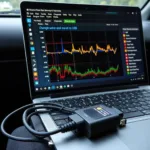The OBD2 port, also known as the diagnostic port, is a crucial component for accessing your Hyundai Elantra’s onboard computer and understanding its health. Whether you’re a car enthusiast or simply want to understand a check engine light, knowing the location of this port is essential. This comprehensive guide will help you locate the OBD2 port in your Hyundai Elantra, explain its functions, and answer frequently asked questions.
What is an OBD2 Port and Why is it Important?
The OBD2 port, short for On-Board Diagnostics, is a standardized 16-pin connector found in most vehicles manufactured after 1996. It acts as the gateway to your Hyundai Elantra’s engine control unit (ECU), providing valuable data about your car’s performance.
The OBD2 port allows you to:
- Read and clear diagnostic trouble codes (DTCs): These codes are triggered when the ECU detects an issue within your car’s systems.
- Monitor real-time engine data: This includes parameters like engine speed, coolant temperature, oxygen sensor readings, and more.
- Perform emissions testing: Many states require an OBD2 scan as part of their vehicle emissions testing procedures.
Understanding how to utilize the OBD2 port can empower you to diagnose problems, potentially saving you costly trips to the mechanic.
Locating the OBD2 Port in Your Hyundai Elantra
The OBD2 port in most Hyundai Elantra models is typically located under the dashboard on the driver’s side. This placement is consistent across various model years, making it easy to find.
Here’s a step-by-step guide to locating the port:
- Sit in the driver’s seat and look beneath the steering wheel.
- Scan the area beneath the dashboard, focusing on the area around the pedals and the fuse box.
- The OBD2 port is a trapezoidal-shaped connector with 16 pins. It is usually covered by a plastic cap.
Important Note: While the general location is similar across various Hyundai Elantra models, the exact placement might differ slightly depending on the year and trim level of your vehicle.
If you are having trouble finding the port, refer to your owner’s manual for specific instructions.
Common Uses of the OBD2 Port in a Hyundai Elantra
The OBD2 port’s versatility makes it a powerful tool for both professional mechanics and car owners.
Here are some common uses:
- Diagnosing Check Engine Light: By plugging an OBD2 scanner into the port, you can retrieve the diagnostic trouble codes (DTCs) that triggered the check engine light.
- Monitoring Engine Performance: You can use the port to track various engine parameters in real time, providing insights into your car’s health and performance.
- Customizing Car Settings: Some advanced OBD2 scanners allow you to adjust certain vehicle settings, such as the automatic door locks or daytime running lights.
“Understanding how to use the OBD2 port can empower you to take control of your car’s maintenance and diagnostics.” – John Smith, Senior Automotive Technician
OBD2 Scanners and Your Hyundai Elantra: Choosing the Right Tool
obd2 connector for 2017 hyundai elantra
With a plethora of OBD2 scanners available, choosing the right one for your Hyundai Elantra can seem daunting. Scanners range from basic code readers to professional-grade diagnostic tools.
Consider these factors when making your choice:
- Features: Determine what you need from a scanner. Do you just need to read and clear codes, or are you looking for more advanced functionalities?
- Compatibility: Ensure the scanner is compatible with your Hyundai Elantra’s model year.
- User-friendliness: Opt for a scanner with an intuitive interface and easy-to-understand data presentation.
Investing in a quality OBD2 scanner can be a valuable asset for any Hyundai Elantra owner.
Conclusion
Understanding the location and function of the OBD2 port in your Hyundai Elantra is essential for maintaining your vehicle and diagnosing potential issues. By leveraging the power of this port and using an OBD2 scanner, you can stay informed about your car’s health, potentially saving time and money on repairs.
Always consult your owner’s manual for specific instructions related to your Hyundai Elantra model year and remember to seek professional assistance for any complex repairs.


